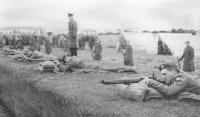The FCA
Published in 20th-century / Contemporary History, General, Issue 5 (Sept/Oct 2011), Letters, Volume 19
The photograph of FCA range practice in 1963, with Lee-Enfield No. 4 rifles, does not denote antiquated equipment.
Sir,—I read Terence O’Reilly’s article (HI 19.4, July/August 2011) with interest, as I’m sure did many readers who had served in the FCA, for over the years it gave scores of thousands of citizens either their only taste of soldiering or the basis for their professional careers. It’s true that the Defence Forces were underfunded, as were other services like education and health, but I doubt whether their commitment was less than that of such services. The photograph of the FCA presidential guard of honour suggests a pretty well-drilled force, while that of the range practice, in 1963, with Lee-Enfield No. 4 rifles does not denote antiquated equipment.I was first issued with this model in 1959 in the grounds of Howth demesne, and it came from its crate in mint condition and had been manufactured in 1954. The regulars were issued with the No. 4 rifle in the mid-1950s, and when they went to the Congo in 1960 it was their standard issue, like that of the Indian Army contingents that served alongside them. Our Howth platoon and others in the company in Artane, Donnycarney and Swords kept our rifles at home, as I understand did the other Dublin companies, contrary to your correspondent’s account.FCA men were issued with new trousers and tunics every three years, but greatcoats were issued only every five. As many of us added a couple of years to our age on joining, so eager were we to serve our country, our calf-length greatcoats, which could withstand an Arctic storm, were nearly ‘bum-freezers’ with half-length sleeves by the time we got replacements. Incidentally, the tunics—or ‘blousons’, as the fashion magazines would now call them—must have been the worst-designed and worst-cut garments in history.It seems to have been a tradition that on arrival at summer camp those considered too scruffy to appear on parade were assigned cookhouse duties, but such was the robust constitution of their comrades that nobody died of food poisoning. Recruits from impeccable backgrounds returned from camp with the rudiments of military education, rude, too, in health and language, and were known to ask parents and siblings ‘to pass the f***ing sugar’. They may not have been ‘bearded like the pard’ but being ‘full of strange oaths’ played the soldier’s part in the ‘Seven Ages of Man’.Your correspondent refers to the equipping of the 11th Cavalry Regiment with ‘deanta in Éirinn’ Ford armoured cars in 1948 but doesn’t say that they replaced man-powered bicycles. By chance, shortly before reading the article, I’d read another article—‘My kingdom for an AFV (armoured fighting vehicle)’ by Seamus Ó Diolúin, written at the time in An Cosantoir, which can be accessed on line. The implications for part-timers, whose normal training took two hours per week, were enormous. Very few young men had driving experience following World War II, which had ensured that petrol was unavailable for many years for the few cars that were about at the time. Coy. Sgt Ó Diolúin, a barrister in civilian life, transferred to the infantry and served with the Howth platoon. He wrote various pieces on the FCA in An Cosantoir. He won at least one Oireachtas prize for writings in Irish.—Yours etc.,DONAL KENNEDY London
















